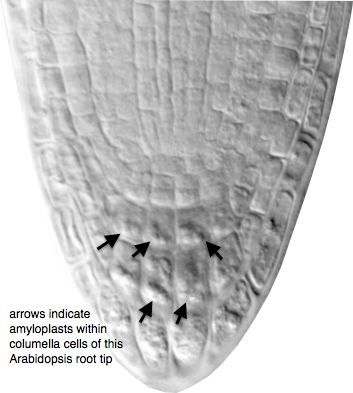 Immediately following germination, as the root emerges from the seed, it is faced with a decision: which way to grow? From the standpoint of adaptation, roots need to find a source of water and minerals quickly in order to sustain growth, both their own and that of the emerging shoot. Because water always flows downhill, the question of which way to grow seems to be reducible to, “Which way is down?”
Immediately following germination, as the root emerges from the seed, it is faced with a decision: which way to grow? From the standpoint of adaptation, roots need to find a source of water and minerals quickly in order to sustain growth, both their own and that of the emerging shoot. Because water always flows downhill, the question of which way to grow seems to be reducible to, “Which way is down?”
In order for the plant to detect its position in a gravity field, it must have some way to transduce the acceleration force due to gravity into cellular information. Most evidence points to the change in position of starch-filled plastids (called amyloplasts) within the cell as playing a central role in sensing the position of the organ in the gravity field. As an organ elongates and becomes displaced from vertical, these amyloplasts sediment to the new lower side of the cell due to their high density relative to the cytoplasm. These amyloplasts, therefore, act as statoliths, and their role in sensing gravity is known as the starch-statolith hypothesis.

There are several strong pieces of evidence to support the starch-statolith hypothesis. Plants that are unable to synthesize starch due to a mutation in a gene encoding a key enzyme in that process show a significant reduction in gravity responses, even though their growth rates are nearly wild-type. Similarly, mutants with intermediate levels of starch biosynthesis show gravity responses that correlate with the amount of statolith movement. Thus, full gravity sensitivity seems to require a full complement of starch within the amyloplasts to provide the density necessary for statolith sedimentation.
If the movement of statoliths within the gravity-sensing cells is sufficient to induce a growth response, then causing the movement of the statoliths by some other means besides gravity stimulation should induce a growth response as well. In a clever series of experiments, one team of researchers accomplished just such displacement of statoliths in vertically-growing roots. By taking advantage of the diamagnetic properties of starch, coupled with the ability to displace a diamagnetic material in a high-gradient magnetic field (HGMF), they induced root curvature similar to gravitropic growth by ‘pushing’ the statoliths within the cell.
A final kind of evidence implicating statolith sedimentation in gravity sensing comes from experiments in which the tissue containing the statoliths is somehow disturbed. The earliest reports of this kind of disturbance date to the mid-19th century. In roots of some species, the root cap is relatively easy to surgically remove without damaging the meristem. Upon removal, the root loses its ability to respond to gravity, and it slowly regains it as the cap is replaced through continued cell divisions. In a much more modern interpretation of this decapping experiment, investigators used laser ablation to obliterate specific tiers of the columella cells in the root cap, concluding that much of the gravity sensing appears to reside in cells in the second and third tiers of the columella.
Unlike in the root, where much gravity sensing appears to be localized to the root cap columella cells, sensing is distributed throughout the growing region of the young shoot. In dicots, sedimenting amyloplasts are found in the endodermis, a cyclinder of tissue throughout the stem just outside the vascular cylinder. In monocots, which produce a protective sheath called a coleoptile that encloses the emerging leaf, amyloplasts are distributed throughout the sheath.